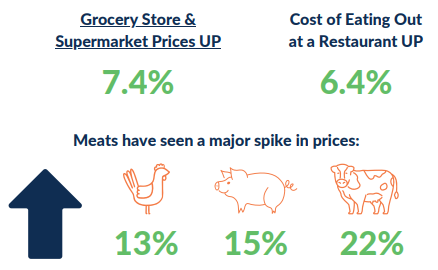What’s on the Menu?
Rising Food Prices & Managing Your Insurance CostsAs we transition to a post-pandemic world, restaurants across the country have continued to feel the ripple effects of the coronavirus pandemic. Though customers are now resuming dining out, the price of food has skyrocketed. Faced with higher food costs, restaurants are raising menu prices in an attempt to preserve profits.
According to the U.S. Department of Agriculture, compared to January 2021, in January 2022, grocery store and supermarket prices were up by 7.4 percent while the cost of eating out at a restaurant rose by 6.4 percent. Meats have seen a major spike in prices, with chicken up 13 percent, pork up 15 percent, and beef up 22 percent. To put things into perspective, prior to the pandemic, the average annual increase of food purchases was 1.3 percent.
So, what’s causing the cost of food to go up at rates we haven’t seen since 1990? Unfortunately, like with many other industries, restaurants are grappling with the effects of supply chain disruptions, labor shortages, extreme weather events, and higher energy prices on the cost of food.

Supply Chain Disruption
Bottlenecked supply chains continue to negatively impact the price and availability of food. A shortage of truck drivers and shipping containers, as well as massive strikes over low pay throughout the supply chain are driving up food prices. Overseas producers provide foods like grains and meats in addition to materials used for food packaging. Supply chain disruptions continue to limit access to international goods in the U.S., which translates to higher food costs.
Labor Shortages
Food manufacturers continue to struggle with finding enough workers to meet the demand for their products. There aren’t enough workers to unload containers in ports or package food in food processing plants. Though many employers are increasing pay and benefits to attract and retain talent, there are still too many unfilled positions within the food manufacturing industry to keep up with the demand for food, which raises the price of food goods.
Extreme Weather Events
Drought and extreme weather events in agricultural hubs around the world have worsened the food crisis. Both of these phenomena have led to decreased production or wiped out crops entirely. The unavailability of crops limits global supply, which translates to increased pricing.
Higher Energy Prices
We’re currently experiencing higher energy prices, driven by myriad factors including extreme weather events, increased demand, and conflicts around the world. Fuel feeds the food industry by powering all operations. From fertilizer, manufacturing, and transportation, all parts of the food supply chain have an energy component.
Whether higher food prices are here to stay is yet to be seen, but it’s clear that it’s an issue not likely to go away any time soon because of the scale and complexity of factors driving growing costs. The hope is that food prices will moderate once the supply chain becomes less constrained and that labor shortages will go away. Unfortunately, both the supply chain and the hospitality industry will likely have to grapple with labor shortages, as many workers’ expectations for what they want from a job shifted dramatically over the course of the pandemic.
Despite these difficult circumstances, the hospitality industry can implement risk management strategies to limit exposures and lower overall cost of insurance. Connect with us to explore what you can do to navigate this complex risk landscape.
This material has been prepared for informational purposes only. BRP Group, Inc. and its affiliates, do not provide tax, legal or accounting advice. Please consult with your own tax, legal or accounting professionals before engaging in any transaction.
Download the Article
Rising Food Prices & Managing Your Insurance Costs
